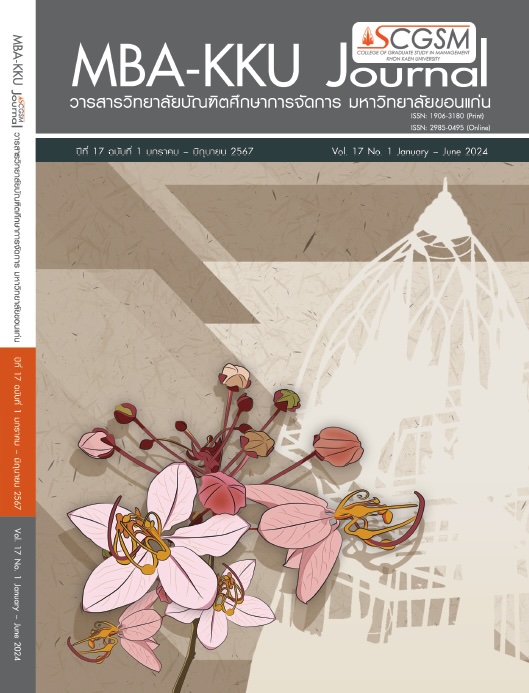A Strategic Policy Formulation for Air Transport by Backcasting Approach
Main Article Content
Abstract
The purpose of this research is to analyze the current state of the air transport market in Thailand and formulate a strategic policy for air transport in Thailand (AirTrans’30: 2021-2030). Data were collected through semi-structured in-depth interviews and focused groups, engaging 29 informants. The collected data were analyzed by content analysis and backcasting approach. The research results revealed nine key change drivers that have shaped the air transport market in Thailand from the past to the present. Major were uncovered regarding the liberalization of air transport in Thailand. Moreover, several future key drivers emerged as crucial for reshaping the air transport market landscape and guiding strategic policy formulation for air transport in Thailand. Seven key elements were defined for strategic policy development, including policy maker and regulator capacity building, competition and consumer rights, and public participation. The policy path was constructed by dividing the period of strategic policy implementation into two main phases, namely (1) Phase 1 (2021-2025), divided into Phase 1.1 (2021-2022) covering 80 measures and Phase 1.2 (2023-2025) covering 74 measures (2) Phase 2 (2026-2030) covering 73 measures.
Article Details

This work is licensed under a Creative Commons Attribution-NonCommercial-NoDerivatives 4.0 International License.
- The ideas and opinions expressed in MBA-KKU Journal are those of the authors and not necessarily those of the editor.
- Copyright on any open access article in a journal published by MBA-KKU Journal
References
นวทัศน์ ก้องสมุทร, มานะ ลักษมีอรุโณทัย, พิมพ์พร โสววัฒนกุล, ลลิล ก่อวุฒิกุลรังษี, ประเสริฐ ป้อมป้องศึก, กฤติกา เลิศสวัสดิ์ และคณะ. (2563). โครงการการศึกษาเพื่อการพัฒนานโยบาย การกำกับดูแล และขีดความสามารถในการแข่งขันของอุตสาหกรรมการบินของประเทศ: รายงานฉบับสมบูรณ์. สํานักงานคณะกรรมการส่งเสริมวิทยาศาสตร์ วิจัยและนวัตกรรม
พูลภัทร์ ชมจิตต์, วัฒนา มานนท์ และวราภรณ์ เต็มแก้ว. (2558). ปัจจัยที่มีผลต่อการตัดสินใจของกลุ่มเจนเนอเรชั่นวายกับการเลือกใช้บริการเดินทางระหว่างประเทศของสายการบินของไทย. วารสารวิทยาลัยบัณฑิตศึกษาการจัดการมหาวิทยาลัยขอนแก่น, 8(2), 39-54.
สำนักเลขาธิการคณะรัฐมนตรี. (2566). สรุปข่าวการประชุมคณะรัฐมนตรี 7 กุมภาพันธ์ 2566. ค้นเมื่อ 8 สิงหาคม 2566, จาก https://www.thaigov.go.th/news/contents/details/64660
Börjeson, L., Höjer, M., Dreborg, K.-H., Ekvall, T., & Finnveden, G. (2006). Scenario types and techniques: Towards a user's guide. Futures, 38(7), 723-739.
Giaoutzi, M., Stratigea, A., Leeuwen, E. v., & Nijkamp, P. (2012). Scenario analysis as a foresight tool in agriculture. International Journal of Foresight and Innovation Policy, 8(2/3), 105-128.
Hitt, M. A., Ireland, R. D., & Hoskisson, R. E. (2016). Strategic Management: Competitiveness and Globalization (Concepts). 12th edition. Victoria: Cengage Learning.
Hooper, P. (1998). Airline competition and deregulation in developed and developing country contexts —
Australia and India. Journal of Transport Geography, 6(2), 105-116.
IATA. (2016). The Importance of Air Transport to Thailand. Montreal: International Air Transport Association.
ICAO. (2016). Overview of Regulatory and Industry Developments in International Air Transport. Montreal: International Civil Aviation Organization.
Itani, N. M. (2015). Policy development framework for aviation strategic planning in developing countries [Ph.D. Thesis, Cranfield University. Cranfield.
Kongsamutr, N. (2020). Impact on Thai Airways of Air Transport Liberalisation in Thailand. In J. W. Lee (Ed.), Aviation Law and Policy in Asia: Smart Regulation in Liberalized Markets (pp. 221-234). Leiden: Brill | Nijhoff.
Lelieur, I. (2003). Law and Policy of Substantial Ownership and Effective Control of Airlines. New York: Routledge.
Mintzberg, H. (2000). The Rise and Fall of Strategic Planning. Harlow: Financial Times-Prentice Hall.
Mintzberg, H . (2005). Launching Strategy. In Strategy Bites Back: It Is Far More, and Less, than You Ever Imagined (pp. 103-116). Harlow: Financial Times-Prectice Hall.
OECD. (2011). Together for Better Public Services: Partnering with Citizens and Civil Society. Paris: OECD Public Governance Reviews.
OECD. (2017). Policy Advisory Systems: Supporting Good Governance and Sound Public Decision Making. Paris: OECD Public Governance Reviews.
OECD. (2019). Governance as an SDG Accelerator: Country Experiences and Tools. Paris: OECD Publishing.
OECD. (2020). Policy Framework on Sound Public Governance: Baseline Features of Governments that Work Well. Paris: OECD Publishing.
Piermartini, R., & Rousova, R. (2008). Liberalization of Air Transport Services and Passenger Traffic. Geneva: World Trade Organization.
POSSUM-Project. (1998). Transport RTD Programme, 4th Framework Programme. Brussel: European Commission.
Renn, O., & Thomas, M. (2002). The Potential of Regional Foresight: (Final Report of the STRATA-ETAN Expert Group "Mobilising the Regional Foresight Potential for an Enlarged European Union - an Essential Contribution to Strengthen the Strategic Basis of the European Research Area (ERA), Issue. Luxembourg: Office for Official Publications of the European Communities.
Robinson, J. B. (1982). Energy backcasting A proposed method of policy analysis. Energy Policy, 10(4), 337-344.
Robinson, J. B. (1990). Futures under glass: A recipe for people who hate to predict. Futures, 22(8), 820-842.
VIBAT-Project. (2009). 20 Percent Transport – Visioning and Backcasting for Transport in London–VIBAT London. London: Department for Transport.
Webster, J. L., Reif, W. E., & Bracker, J. S. (1989). The Manager's guide to strategic planning tools and techniques. Planning Review, 17(6), 4-8.
Wheelen, T. L., & Hunger, J. D. (2012). Strategic Management and Business Policy: Toward Global Sustainability. New Jersey: Pearson Prentice Hall.


